13 min read • Sustainability
WALKING THE TALK ON CORPORATE SUSTAINABILITY
The COP26 summit saw progress in some areas and disappointment in others. The agreement seeks to keep the hope of maintaining temperature rise within 1.5C alive by inviting countries to submit new plans. However, it seems clear that reliance on national governments and supranational organizations alone will not be enough.

Business has a crucial role to play, accounting for some two-thirds of global greenhouse gas emissions1. Most businesses in the developed economies have already taken at least some measures, however limited, to reduce carbon footprints in the last 20 to 30 years. Today the pace of action within businesses is rapidly accelerating – though some observers would criticize business for achieving too little, too late.
In the last edition of Prism (second semester 2021), we published an article on why corporate sustainability was now genuinely at the top of the business agenda, and how a partner ecosystem-based approach was key. (Refer to Corporate sustainability – Using your ecosystem to sustain the ecosystem, Prism S2 2021.) Undoubtedly, we are seeing a new level of activity, driven by a combination of increased customer awareness and demand, developing government policies, rising emission costs, technological progress and plentiful green finance2.
Yet despite the new impetus, skepticism about the ability of business to deliver on its promises remains. For example, Al Gore wrote in his 2021 Sustainability Trends Report that there “remains a yawning gap between long-term climate goals and near-term action plans.” National consumer protection authorities (source: Bloomberg, GIM) estimate that 42 percent of environmental claims have been “exaggerated, false or deceptive,” and might even violate fair practice rules established by the European Union. Separately, data from Climate Action 100+ shows that about 53 percent of the 159 companies it tracks – which include the world’s largest emitters of greenhouse gases – don’t have appropriate short-term targets for Net Zero emissions.
Is this criticism fair? Behind all the public messages, to what extent is business really “walking the talk” on sustainability? In this article we consider how companies are progressing in embedding sustainability into their strategy, governance and organization. Drawing on the results of a recent Arthur D. Little company survey on this topic, we look at some of the main challenges that companies are facing and how they can be best overcome.
HIGHLIGHTS AND LESSONS FROM THE SURVEY
In the third quarter of 2021, ADL conducted an anonymous questionnaire-based survey focusing on the degree of integration of sustainability into business models and organizations across more than 85 large and medium-sized companies. The coverage was pan- sector and pan-geography, although with a stronger focus on Europe- based organizations. Some 40 percent of companies come from the process industries (the chemicals, construction, industrial goods & services and oil & gas sectors).
1. COMPANY EMPLOYEES STILL DO NOT UNDERSTAND SUSTAINABILITY STRATEGIES WELL
By now there are few companies of any size that do not have any sustainability strategy at all. However, it’s one thing to have a strategy, and another to translate it into action. One of the most common challenges companies face is that sustainability strategies are not well understood by employees. For example, our survey indicated that less than one-third of companies had a sustainability strategy whose impact was clear to all employees. (See Figure 1.)
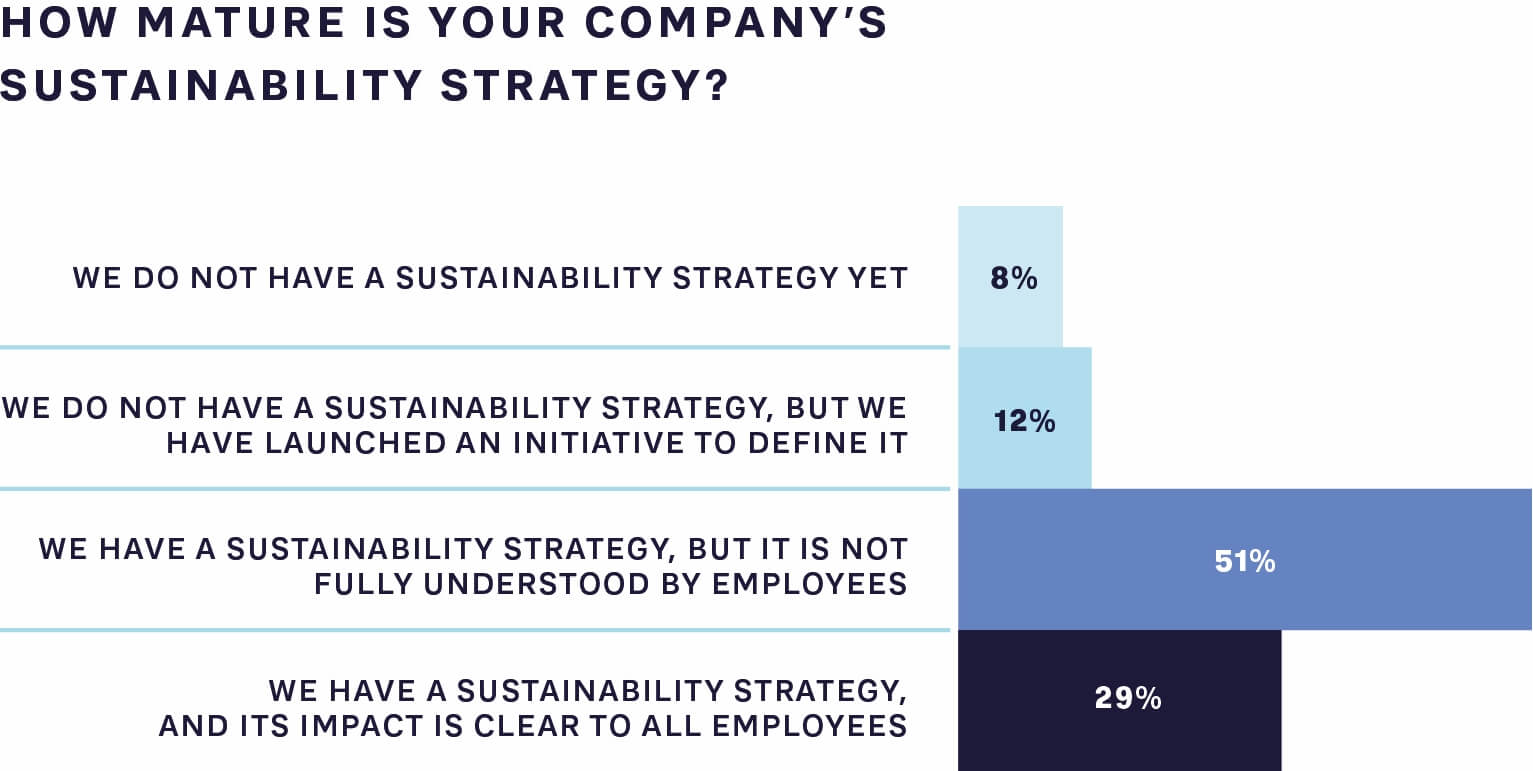
FIGURE 1: MATURITY OF SUSTAINABILITY STRATEGY
The main reason for this lack of understanding is that companies struggle to create a common language on sustainability across the entire organization, in a way that conveys to employees across different functions and levels what it means for the business day to day.
This is also evident in the fairly limited extent to which sustainability strategy has affected the core business of the companies in our survey (Figure 2).
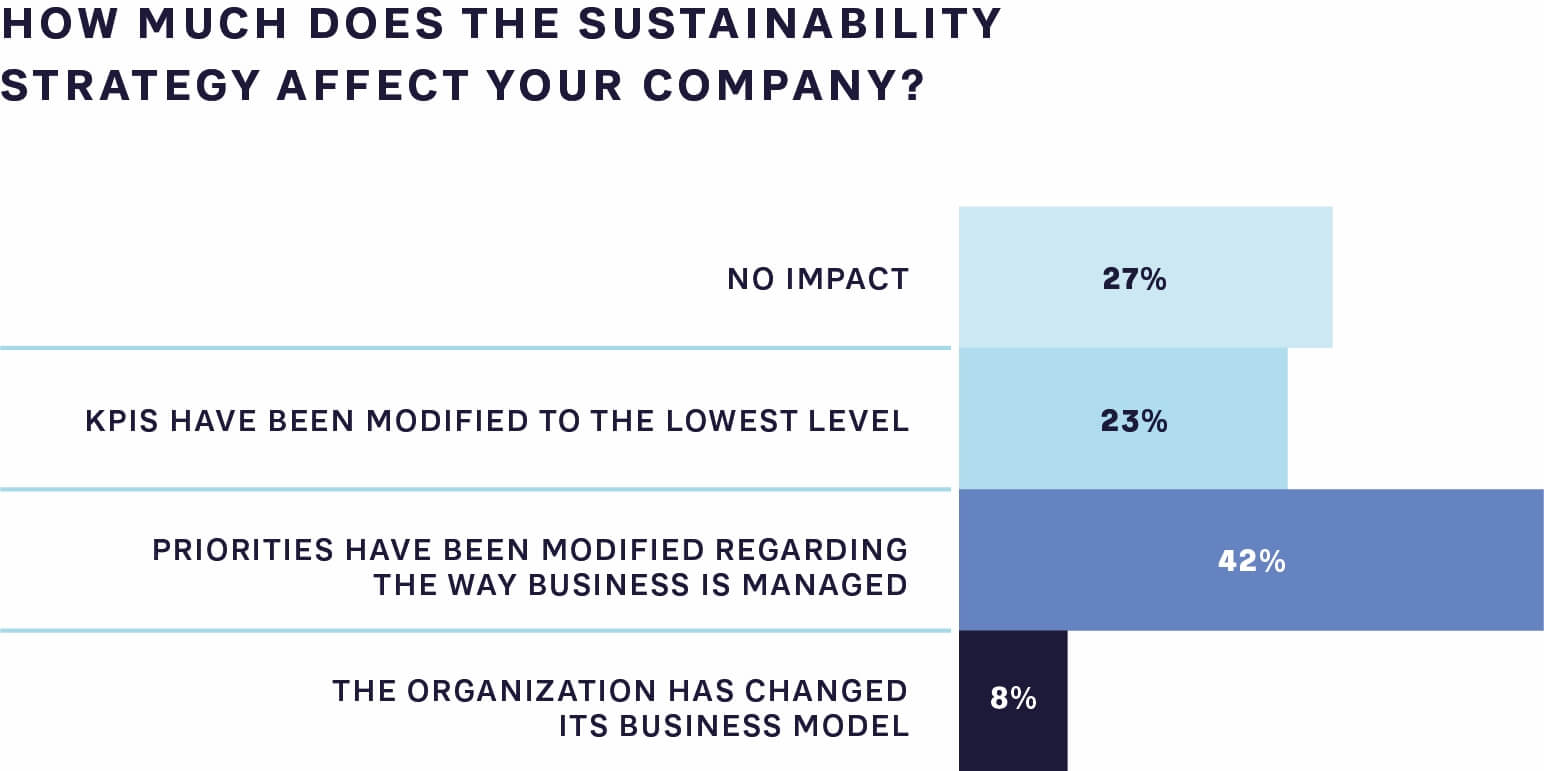
FIGURE 2: IMPACT OF SUSTAINABILITY STRATEGY
It can be seen that less than half (42 percent) of the companies have modified their ways of managing the business as a result of implementing a sustainability strategy, and only 8 percent have gone as far as actually changing their business model. Only one-quarter have modified their full range of key performance indicators (KPIs).
Lessons learned – Create a common language through adopting better tools to define sustainability performance
So, what approaches have companies taken to help create a common language that employees understand? Some sustainability leaders have tackled this problem by implementing approaches and tools to define and measure sustainability performance transparently at the product and portfolio level. For example, the chemicals and materials industry has created an accepted global industry standard for conducting portfolio sustainability assessments (PSAs), using a set of tools developed by the World Business Council for Sustainable Development, with assistance from ADL. This approach allows an objective assessment of the sustainability performance of a product in a specific application and/or region.
This is invaluable for creating alignment on sustainability in very practical terms, both internally across the staff and externally to other stakeholders. It also forms the basis for focused dialogues with suppliers and customers on how to collaborate better to jointly improve sustainability performance. In this way it highlights potential risks, but also substantially contributes to innovation.
Once the language is understood and shared, it becomes much easier to demonstrate how good sustainability management creates business value, for example, through improved customer satisfaction, reduction of product portfolio risk, boosting of activities with an excellent sustainability rating, better focus of R&D and CAPEX investments, and timely adaptation of supply chains.
2. SUSTAINABILITY COMMITMENTS ARE NOT GETTING THE SAME PRIORITY AS OTHER BUSINESS OBJECTIVES
One of the clearest indicators of the extent to which sustainability is embedded into the business is how it is reflected in senior management incentives and bonuses. Our survey showed that nearly two-thirds (65 percent) of companies did not link sustainability performance to senior management incentives. A very small minority (6 percent) reflected sustainability in terms of 15 percent or more of the managerial bonus (Figure 3).

FIGURE 3: LINKAGE OF SUSTAINABILITY TO INCENTIVES
What’s more, many companies have a bonus system that involves some form of cascade from senior management down to employees. Influencing employees and changing culture, which is key for success, is not easy unless incentives are properly aligned across multiple levels in the hierarchy. Of course, not every company needs to have a significant part of executive bonuses linked to sustainability performance. Businesses are diverse, and some sectors have an innately bigger sustainability impact than others – for example, companies that offer services generally have a lower impact than those that make or process things.
The way in which sustainability performance is reported publicly is also an indicator of its perceived importance to the business (Figure 4).
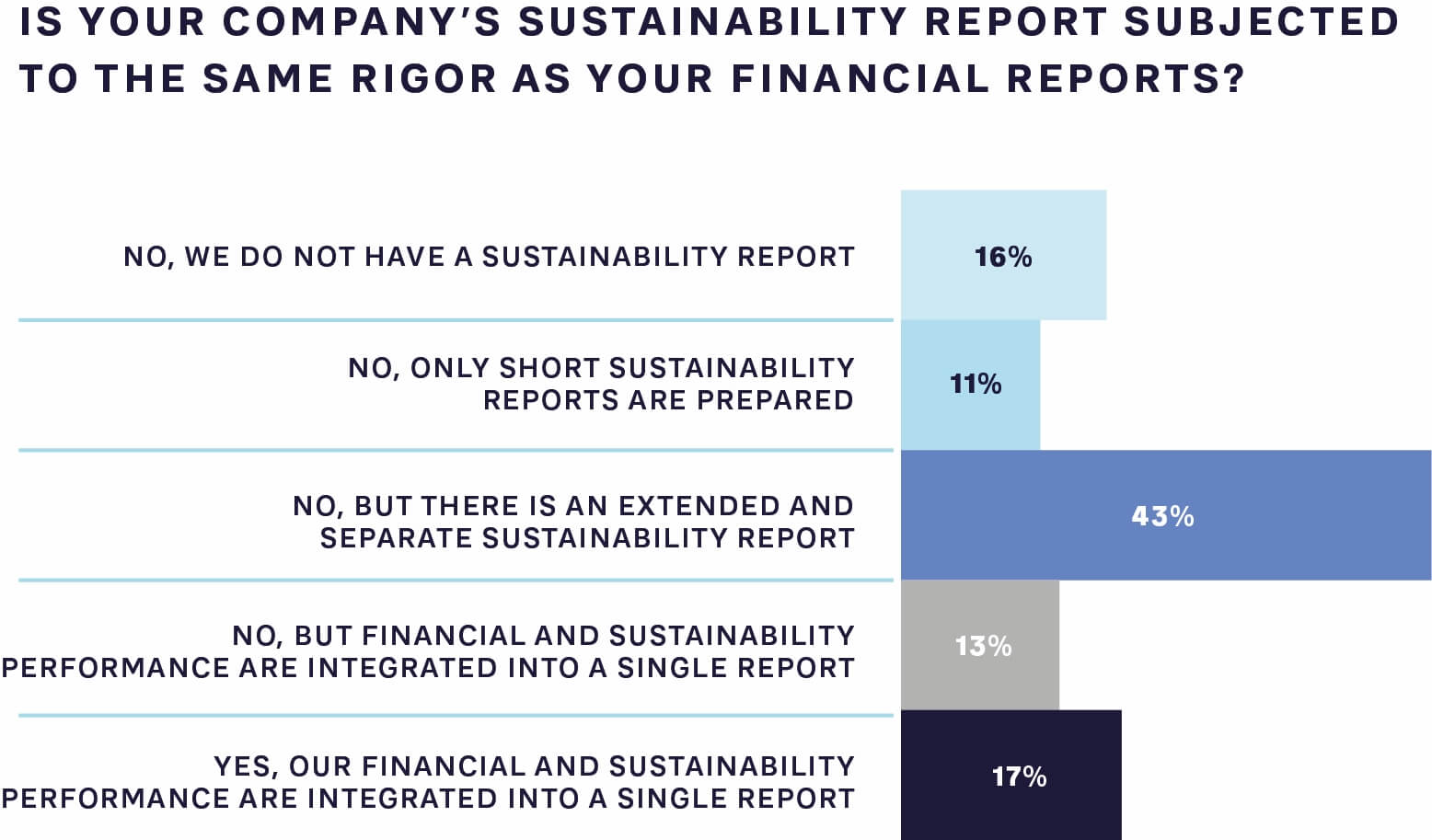
FIGURE 4: SUSTAINABILITY REPORTING
Figure 4 shows that although 84 percent of companies have a sustainability report, only 17 percent use the same reporting rigor as they do for financial performance and integrate it into a single report. This reflects the current reality that financial reporting of sustainability impacts is still in the development phase. For example, few corporations have yet properly adopted financial models that incorporate new ways of accounting for externalities, such as social return on investment (SROI) and creating shared value (CSV) models. This is starting to change as shareholders and investors become more sophisticated in their consideration of environmental and social governance (ESG) issues, but there is still some way to go. A further challenge is that financial results are generally reported monthly, quarterly and annually, yet the benefits of good sustainability often manifest themselves over a much longer period.
Lessons learned – Develop a carefully balanced set of sustainability indicators to be reflected in senior management incentives and external reports
The relatively limited adoption of linkages between sustainability performance and incentives shown in the survey is, to some degree, a reflection of the difficulty of selecting meaningful and appropriate indicators. For example, some ESG criteria, such as stakeholder impact or employee engagement, are difficult to measure in practice. Others, such as progress towards Net Zero impact, are not only hard to measure, but may also be too long term to be meaningful for an annual renumeration package. A recent study from the Executive Remuneration Center of the Vlerick Business School concluded that ESG criteria in board incentive structures were often poorly defined, with the result that targeted progress in sustainability performance was not achieved. Companies should therefore work towards developing and reporting on a balanced set of indicators suitable for their business, taking into account some important principles, for example:
-
Reflect short-term ESG goals in incentives, not just over-arching long-term goals. (See also section 3 below.)
-
Ensure that any ESG goals set for remuneration purposes are properly reflected in the corporate strategy, not just add-ons.
-
Consider realistic sustainability impacts along the entire supply chain, not just within the company boundaries, taking a broad stakeholder view. (See also section 4 below.)
-
Consider more than just one dimension of ESG impact, for example, not just climate change, but also waste, energy, diversity and inclusion, etc.
-
Balance lagging impact measures (such as emissions) with leading proactive measures (such as controls implemented).
Corporate governance has an important role to play in this respect – the board is often in a better position to take a longer perspective in the broader interests of shareholders than the executive.
3. THERE IS OFTEN A LACK OF PRACTICAL PLANNING AROUND HOW TO ACHIEVE PUBLICLY DECLARED SUSTAINABILITY GOALS
While ambitious long-term targets and goals are often publicly declared, there is frequently a lack of practical planning around what these goals mean in the short- and medium term (Figure 5).
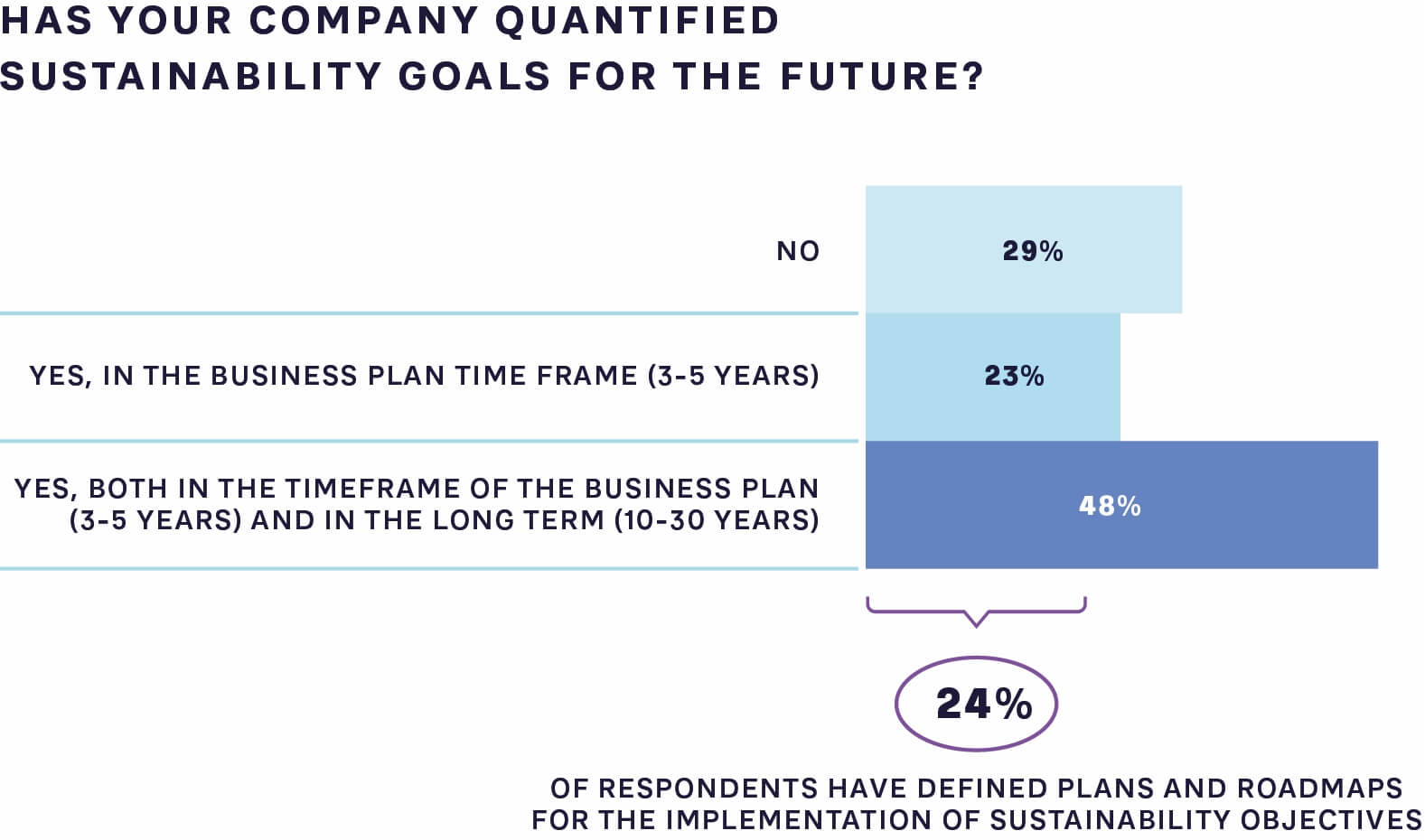
FIGURE 5: SUSTAINABILITY GOALS AND PLANNING
Less than half (48 percent) of the companies in the survey have set sustainability goals that include both the normal three-to-five-year planning horizon and the longer-term goal of 10–30 years. Only 24 percent have structured plans, roadmaps and milestones to achieve the goals. Nearly one-third have set no goals at all.
Setting ambitious sustainability goals and communicating these to stakeholders can be risky if not backed up by a robust strategy and implementation roadmap. There are many examples of companies having to rapidly implement painful internal processes – including divestments – to reassure stakeholders when previously declared targets are not met. At the other end of the scale, some companies adopt a policy of simply reflecting legal obligations, for example, “Net Zero by 2050” for Europe-based companies, which may not be enough to drive the necessary changes.
Lessons learned – Ensure that long-term goals are supported by meaningful roadmaps
To avoid these problems, companies need to ensure that five-year- plus goals are supported by meaningful roadmaps with intermediate short-terms goals and actions. Just as importantly, there needs to be a defined and agreed process for monitoring progress versus these goals. This can be more complex than some companies expect.
Danone is a good example of a company that has a well-structured set of sustainability goals. Danone is committed to a sustainable shared value creation model: “One Planet. One Health.” Its set of nine long-term goals aligns with both this internal model and the United Nations 2030 Sustainable Development Goals. There is integration also with Danone’s broader business, brand and trust models. The goals are monitored yearly by a company dashboard, with results also communicated externally.
Another example is IKEA, whose sustainability ambitions for 2030 are to become circular and climate positive, regenerate resources while growing the IKEA business, and create positive social impact for everyone across the company’s value chain. These ambitions are supported by the IKEA People & Planet Positive strategy, which has a long-term roadmap for positive change entailing investments in new technologies, innovative materials, and ways of generating clean energy, as well as in social development.
4. NEARLY ALL COMPANIES BELIEVE GOOD SUSTAINABILITY IS BENEFICIAL TO THE BUSINESS, BUT MANY STILL STRUGGLE TO DRIVE CHANGE
Despite the patchy progress in dealing with the challenges of sustainability after many years, even decades, it would be wrong to conclude that business simply lacks true commitment. For the most part, company leaders are smart individuals who are strongly motivated to “do the right thing” for their stakeholders. For example, the survey confirmed that virtually all companies (approximately 80 percent) believe that sustainability is, as well as being critical for our survival, good business, providing competitive advantage and improving attractiveness to both employees and investors (Figure 6).
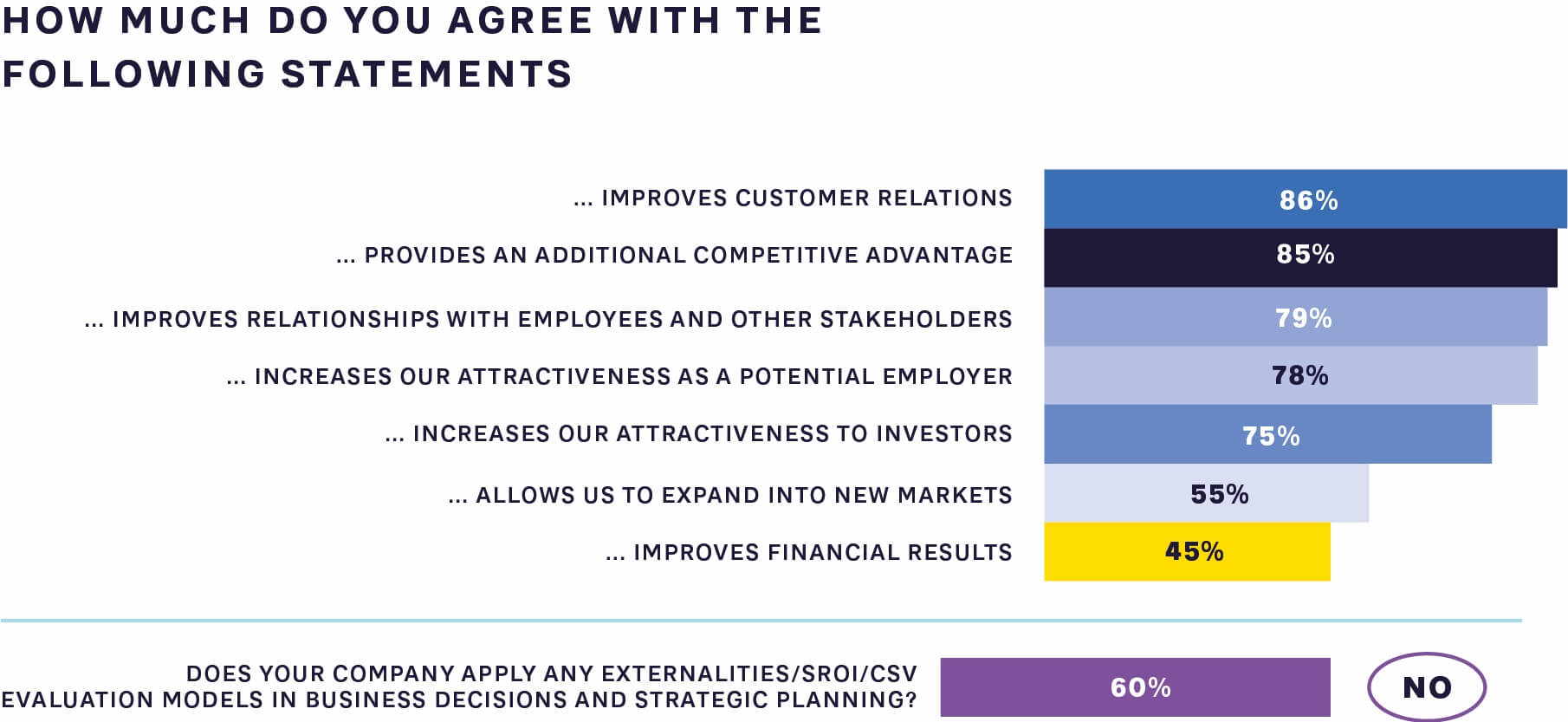
FIGURE 6: BENEFITS OF SUSTAINABILITY
However, the survey also showed that only 45 percent believe good sustainability improves financial results. This is very much connected with the difficulty of reporting the financial impact of sustainability in a meaningful way, as already discussed in point 2 above.
Lessons learned – Focus on people and take a broad stakeholder ecosystem view
There is no simple solution to the problem of translating motivation into change. It requires attention across all the aspects mentioned above, including strategy, governance, planning, organization, monitoring and reporting. However, one underlying priority that helps ensure success is to focus on people, not just inside the company, but across the whole stakeholder ecosystem.
As with any major change, it is ultimately the behaviors of people that will determine what actually happens. This requires not only implementing new systems and processes, but also providing the right training and coaching in what sustainability means for business managers and winning “hearts and minds” through inspiring initiatives, clear communication and leadership by example. As we have said, one of the keys to inspiring employees is to deal with sustainability in an open way as an integral part of the success of the business, rather than as an obligatory set of attitudes or form of corporate political correctness. As with all forms of change, approaches that “pull” people to behave differently, for example, through shared beliefs and values and aligned incentives, are much more effective than those that seek only to “push” them through imposing new rules and restrictions.
In working on changing people, it is critically important to take a broad “partner ecosystem” perspective. This was covered in depth in our previous article, “Corporate sustainability – Using your ecosystem to sustain the ecosystem”. The ecosystem approach means engaging not just with employees and shareholders, but also with suppliers, customers, competitors, government, regulators, communities and start-ups among others. Sustainability is only meaningful when considered in terms of overall impact, which is also key for effective external sustainability measuring and reporting. Companies need to do more than simply adopt one of the many publicly available reporting protocols. Instead, they need to understand better how their impacts take place within the ecosystem, learn from their partners, and design a monitoring and reporting system that is feasible and realistic. Employees who understand the position of their company in the ecosystem, and who are surrounded by like-minded individuals both inside and outside the company, are more likely to buy into sustainability goals and contribute positively.
The ecosystem approach also helps to leverage innovation in sustainability. One typical example among many is the Italian start-up ACBC (standing for “Anything Can Be Changed”), which collaborates with global brands such as Emporio Armani, Save the Duck, Philippe Model and Missoni to produce sneakers designed for the lowest-possible carbon footprint using bio-based or 100 percent recycled materials.
Small companies, especially, often struggle on their own to make the necessary investment of time and money to embed sustainability, yet collectively their impact is significant. Being part of a partner ecosystem, either through direct links to larger corporates or through industry or professional associations, can make a big difference.
INSIGHTS FOR THE EXECUTIVE
Despite the progress that has been made in many parts of the business world, the evidence from the survey confirms that many companies still have some way to go before they can properly “walk the talk” on sustainability.
Yet, in most cases, this is not simply due to a lack of motivation or sincerity on the part of company leadership teams. Rather, it is due to the inherent challenges of truly embedding sustainability into core business. These are, for the most part, practical challenges, such as how to measure and account for sustainability impacts and benefits (i.e., externalities) on equal terms with financial impacts and benefits, how to properly assess overall impacts both downstream and upstream, how to connect long-term goals with short-term targets, and how to engage properly with people both internally and across a wide stakeholder ecosystem.
However, in all these areas there is recent progress. Increasingly, the legal framework is providing the necessary underpinning for companies to make the sometimes-drastic transformations that are required. The financial sector is already being transformed in terms of growing insistence on responsible investment, and green funding is available at levels never seen before. Advances in green technology continue apace, and there is finally evidence of a genuine shift in consumer demand for sustainable products and services.
The need for embedding sustainability is therefore increasingly urgent. Companies should take heed of the key lessons learned from the leaders, including finding a common and transparent language, adopting the right indicators and making them really count, adopting realistic goals and effective ways to measure progress against them, and above all, focusing on people and adopting a stakeholder ecosystem perspective.

13 min read • Sustainability
WALKING THE TALK ON CORPORATE SUSTAINABILITY
The COP26 summit saw progress in some areas and disappointment in others. The agreement seeks to keep the hope of maintaining temperature rise within 1.5C alive by inviting countries to submit new plans. However, it seems clear that reliance on national governments and supranational organizations alone will not be enough.

DATE

Business has a crucial role to play, accounting for some two-thirds of global greenhouse gas emissions1. Most businesses in the developed economies have already taken at least some measures, however limited, to reduce carbon footprints in the last 20 to 30 years. Today the pace of action within businesses is rapidly accelerating – though some observers would criticize business for achieving too little, too late.
In the last edition of Prism (second semester 2021), we published an article on why corporate sustainability was now genuinely at the top of the business agenda, and how a partner ecosystem-based approach was key. (Refer to Corporate sustainability – Using your ecosystem to sustain the ecosystem, Prism S2 2021.) Undoubtedly, we are seeing a new level of activity, driven by a combination of increased customer awareness and demand, developing government policies, rising emission costs, technological progress and plentiful green finance2.
Yet despite the new impetus, skepticism about the ability of business to deliver on its promises remains. For example, Al Gore wrote in his 2021 Sustainability Trends Report that there “remains a yawning gap between long-term climate goals and near-term action plans.” National consumer protection authorities (source: Bloomberg, GIM) estimate that 42 percent of environmental claims have been “exaggerated, false or deceptive,” and might even violate fair practice rules established by the European Union. Separately, data from Climate Action 100+ shows that about 53 percent of the 159 companies it tracks – which include the world’s largest emitters of greenhouse gases – don’t have appropriate short-term targets for Net Zero emissions.
Is this criticism fair? Behind all the public messages, to what extent is business really “walking the talk” on sustainability? In this article we consider how companies are progressing in embedding sustainability into their strategy, governance and organization. Drawing on the results of a recent Arthur D. Little company survey on this topic, we look at some of the main challenges that companies are facing and how they can be best overcome.
HIGHLIGHTS AND LESSONS FROM THE SURVEY
In the third quarter of 2021, ADL conducted an anonymous questionnaire-based survey focusing on the degree of integration of sustainability into business models and organizations across more than 85 large and medium-sized companies. The coverage was pan- sector and pan-geography, although with a stronger focus on Europe- based organizations. Some 40 percent of companies come from the process industries (the chemicals, construction, industrial goods & services and oil & gas sectors).
1. COMPANY EMPLOYEES STILL DO NOT UNDERSTAND SUSTAINABILITY STRATEGIES WELL
By now there are few companies of any size that do not have any sustainability strategy at all. However, it’s one thing to have a strategy, and another to translate it into action. One of the most common challenges companies face is that sustainability strategies are not well understood by employees. For example, our survey indicated that less than one-third of companies had a sustainability strategy whose impact was clear to all employees. (See Figure 1.)

FIGURE 1: MATURITY OF SUSTAINABILITY STRATEGY
The main reason for this lack of understanding is that companies struggle to create a common language on sustainability across the entire organization, in a way that conveys to employees across different functions and levels what it means for the business day to day.
This is also evident in the fairly limited extent to which sustainability strategy has affected the core business of the companies in our survey (Figure 2).

FIGURE 2: IMPACT OF SUSTAINABILITY STRATEGY
It can be seen that less than half (42 percent) of the companies have modified their ways of managing the business as a result of implementing a sustainability strategy, and only 8 percent have gone as far as actually changing their business model. Only one-quarter have modified their full range of key performance indicators (KPIs).
Lessons learned – Create a common language through adopting better tools to define sustainability performance
So, what approaches have companies taken to help create a common language that employees understand? Some sustainability leaders have tackled this problem by implementing approaches and tools to define and measure sustainability performance transparently at the product and portfolio level. For example, the chemicals and materials industry has created an accepted global industry standard for conducting portfolio sustainability assessments (PSAs), using a set of tools developed by the World Business Council for Sustainable Development, with assistance from ADL. This approach allows an objective assessment of the sustainability performance of a product in a specific application and/or region.
This is invaluable for creating alignment on sustainability in very practical terms, both internally across the staff and externally to other stakeholders. It also forms the basis for focused dialogues with suppliers and customers on how to collaborate better to jointly improve sustainability performance. In this way it highlights potential risks, but also substantially contributes to innovation.
Once the language is understood and shared, it becomes much easier to demonstrate how good sustainability management creates business value, for example, through improved customer satisfaction, reduction of product portfolio risk, boosting of activities with an excellent sustainability rating, better focus of R&D and CAPEX investments, and timely adaptation of supply chains.
2. SUSTAINABILITY COMMITMENTS ARE NOT GETTING THE SAME PRIORITY AS OTHER BUSINESS OBJECTIVES
One of the clearest indicators of the extent to which sustainability is embedded into the business is how it is reflected in senior management incentives and bonuses. Our survey showed that nearly two-thirds (65 percent) of companies did not link sustainability performance to senior management incentives. A very small minority (6 percent) reflected sustainability in terms of 15 percent or more of the managerial bonus (Figure 3).

FIGURE 3: LINKAGE OF SUSTAINABILITY TO INCENTIVES
What’s more, many companies have a bonus system that involves some form of cascade from senior management down to employees. Influencing employees and changing culture, which is key for success, is not easy unless incentives are properly aligned across multiple levels in the hierarchy. Of course, not every company needs to have a significant part of executive bonuses linked to sustainability performance. Businesses are diverse, and some sectors have an innately bigger sustainability impact than others – for example, companies that offer services generally have a lower impact than those that make or process things.
The way in which sustainability performance is reported publicly is also an indicator of its perceived importance to the business (Figure 4).

FIGURE 4: SUSTAINABILITY REPORTING
Figure 4 shows that although 84 percent of companies have a sustainability report, only 17 percent use the same reporting rigor as they do for financial performance and integrate it into a single report. This reflects the current reality that financial reporting of sustainability impacts is still in the development phase. For example, few corporations have yet properly adopted financial models that incorporate new ways of accounting for externalities, such as social return on investment (SROI) and creating shared value (CSV) models. This is starting to change as shareholders and investors become more sophisticated in their consideration of environmental and social governance (ESG) issues, but there is still some way to go. A further challenge is that financial results are generally reported monthly, quarterly and annually, yet the benefits of good sustainability often manifest themselves over a much longer period.
Lessons learned – Develop a carefully balanced set of sustainability indicators to be reflected in senior management incentives and external reports
The relatively limited adoption of linkages between sustainability performance and incentives shown in the survey is, to some degree, a reflection of the difficulty of selecting meaningful and appropriate indicators. For example, some ESG criteria, such as stakeholder impact or employee engagement, are difficult to measure in practice. Others, such as progress towards Net Zero impact, are not only hard to measure, but may also be too long term to be meaningful for an annual renumeration package. A recent study from the Executive Remuneration Center of the Vlerick Business School concluded that ESG criteria in board incentive structures were often poorly defined, with the result that targeted progress in sustainability performance was not achieved. Companies should therefore work towards developing and reporting on a balanced set of indicators suitable for their business, taking into account some important principles, for example:
-
Reflect short-term ESG goals in incentives, not just over-arching long-term goals. (See also section 3 below.)
-
Ensure that any ESG goals set for remuneration purposes are properly reflected in the corporate strategy, not just add-ons.
-
Consider realistic sustainability impacts along the entire supply chain, not just within the company boundaries, taking a broad stakeholder view. (See also section 4 below.)
-
Consider more than just one dimension of ESG impact, for example, not just climate change, but also waste, energy, diversity and inclusion, etc.
-
Balance lagging impact measures (such as emissions) with leading proactive measures (such as controls implemented).
Corporate governance has an important role to play in this respect – the board is often in a better position to take a longer perspective in the broader interests of shareholders than the executive.
3. THERE IS OFTEN A LACK OF PRACTICAL PLANNING AROUND HOW TO ACHIEVE PUBLICLY DECLARED SUSTAINABILITY GOALS
While ambitious long-term targets and goals are often publicly declared, there is frequently a lack of practical planning around what these goals mean in the short- and medium term (Figure 5).

FIGURE 5: SUSTAINABILITY GOALS AND PLANNING
Less than half (48 percent) of the companies in the survey have set sustainability goals that include both the normal three-to-five-year planning horizon and the longer-term goal of 10–30 years. Only 24 percent have structured plans, roadmaps and milestones to achieve the goals. Nearly one-third have set no goals at all.
Setting ambitious sustainability goals and communicating these to stakeholders can be risky if not backed up by a robust strategy and implementation roadmap. There are many examples of companies having to rapidly implement painful internal processes – including divestments – to reassure stakeholders when previously declared targets are not met. At the other end of the scale, some companies adopt a policy of simply reflecting legal obligations, for example, “Net Zero by 2050” for Europe-based companies, which may not be enough to drive the necessary changes.
Lessons learned – Ensure that long-term goals are supported by meaningful roadmaps
To avoid these problems, companies need to ensure that five-year- plus goals are supported by meaningful roadmaps with intermediate short-terms goals and actions. Just as importantly, there needs to be a defined and agreed process for monitoring progress versus these goals. This can be more complex than some companies expect.
Danone is a good example of a company that has a well-structured set of sustainability goals. Danone is committed to a sustainable shared value creation model: “One Planet. One Health.” Its set of nine long-term goals aligns with both this internal model and the United Nations 2030 Sustainable Development Goals. There is integration also with Danone’s broader business, brand and trust models. The goals are monitored yearly by a company dashboard, with results also communicated externally.
Another example is IKEA, whose sustainability ambitions for 2030 are to become circular and climate positive, regenerate resources while growing the IKEA business, and create positive social impact for everyone across the company’s value chain. These ambitions are supported by the IKEA People & Planet Positive strategy, which has a long-term roadmap for positive change entailing investments in new technologies, innovative materials, and ways of generating clean energy, as well as in social development.
4. NEARLY ALL COMPANIES BELIEVE GOOD SUSTAINABILITY IS BENEFICIAL TO THE BUSINESS, BUT MANY STILL STRUGGLE TO DRIVE CHANGE
Despite the patchy progress in dealing with the challenges of sustainability after many years, even decades, it would be wrong to conclude that business simply lacks true commitment. For the most part, company leaders are smart individuals who are strongly motivated to “do the right thing” for their stakeholders. For example, the survey confirmed that virtually all companies (approximately 80 percent) believe that sustainability is, as well as being critical for our survival, good business, providing competitive advantage and improving attractiveness to both employees and investors (Figure 6).

FIGURE 6: BENEFITS OF SUSTAINABILITY
However, the survey also showed that only 45 percent believe good sustainability improves financial results. This is very much connected with the difficulty of reporting the financial impact of sustainability in a meaningful way, as already discussed in point 2 above.
Lessons learned – Focus on people and take a broad stakeholder ecosystem view
There is no simple solution to the problem of translating motivation into change. It requires attention across all the aspects mentioned above, including strategy, governance, planning, organization, monitoring and reporting. However, one underlying priority that helps ensure success is to focus on people, not just inside the company, but across the whole stakeholder ecosystem.
As with any major change, it is ultimately the behaviors of people that will determine what actually happens. This requires not only implementing new systems and processes, but also providing the right training and coaching in what sustainability means for business managers and winning “hearts and minds” through inspiring initiatives, clear communication and leadership by example. As we have said, one of the keys to inspiring employees is to deal with sustainability in an open way as an integral part of the success of the business, rather than as an obligatory set of attitudes or form of corporate political correctness. As with all forms of change, approaches that “pull” people to behave differently, for example, through shared beliefs and values and aligned incentives, are much more effective than those that seek only to “push” them through imposing new rules and restrictions.
In working on changing people, it is critically important to take a broad “partner ecosystem” perspective. This was covered in depth in our previous article, “Corporate sustainability – Using your ecosystem to sustain the ecosystem”. The ecosystem approach means engaging not just with employees and shareholders, but also with suppliers, customers, competitors, government, regulators, communities and start-ups among others. Sustainability is only meaningful when considered in terms of overall impact, which is also key for effective external sustainability measuring and reporting. Companies need to do more than simply adopt one of the many publicly available reporting protocols. Instead, they need to understand better how their impacts take place within the ecosystem, learn from their partners, and design a monitoring and reporting system that is feasible and realistic. Employees who understand the position of their company in the ecosystem, and who are surrounded by like-minded individuals both inside and outside the company, are more likely to buy into sustainability goals and contribute positively.
The ecosystem approach also helps to leverage innovation in sustainability. One typical example among many is the Italian start-up ACBC (standing for “Anything Can Be Changed”), which collaborates with global brands such as Emporio Armani, Save the Duck, Philippe Model and Missoni to produce sneakers designed for the lowest-possible carbon footprint using bio-based or 100 percent recycled materials.
Small companies, especially, often struggle on their own to make the necessary investment of time and money to embed sustainability, yet collectively their impact is significant. Being part of a partner ecosystem, either through direct links to larger corporates or through industry or professional associations, can make a big difference.
INSIGHTS FOR THE EXECUTIVE
Despite the progress that has been made in many parts of the business world, the evidence from the survey confirms that many companies still have some way to go before they can properly “walk the talk” on sustainability.
Yet, in most cases, this is not simply due to a lack of motivation or sincerity on the part of company leadership teams. Rather, it is due to the inherent challenges of truly embedding sustainability into core business. These are, for the most part, practical challenges, such as how to measure and account for sustainability impacts and benefits (i.e., externalities) on equal terms with financial impacts and benefits, how to properly assess overall impacts both downstream and upstream, how to connect long-term goals with short-term targets, and how to engage properly with people both internally and across a wide stakeholder ecosystem.
However, in all these areas there is recent progress. Increasingly, the legal framework is providing the necessary underpinning for companies to make the sometimes-drastic transformations that are required. The financial sector is already being transformed in terms of growing insistence on responsible investment, and green funding is available at levels never seen before. Advances in green technology continue apace, and there is finally evidence of a genuine shift in consumer demand for sustainable products and services.
The need for embedding sustainability is therefore increasingly urgent. Companies should take heed of the key lessons learned from the leaders, including finding a common and transparent language, adopting the right indicators and making them really count, adopting realistic goals and effective ways to measure progress against them, and above all, focusing on people and adopting a stakeholder ecosystem perspective.
